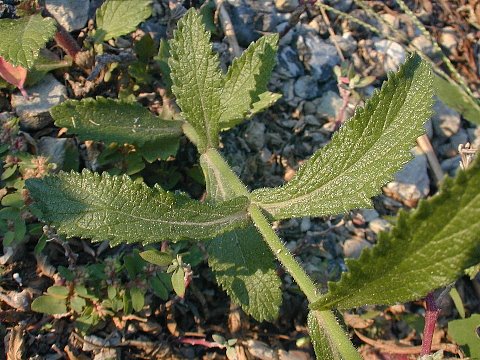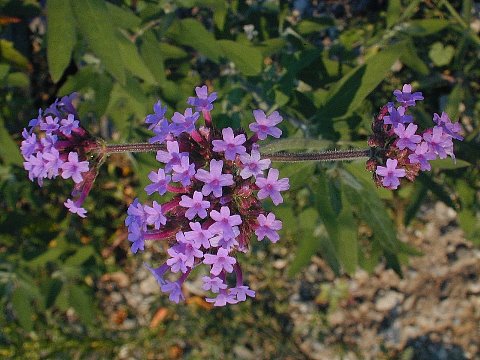
Each cyme consists of a dense flat-topped cluster of flowers spanning about 1-3" across. Individual flowers are about 1/4" (5-6 mm.) across and 1/3" (8-9 mm.) long. Each flower consists of a tubular pinkish purple corolla with 5 spreading lobes, a short tubular calyx with 5 teeth, 4 inserted stamens, and a pistil with a single style. The calyx is light green to reddish purple and hairy, while the lobes of the corolla are slightly notched at their tips. Underneath the flowers, are small lanceolate bractlets (about 1/8" or 3 mm. in length). The blooming period occurs from mid-summer into the fall for about 2-3 months. The flowers have a sweet fragrance. Each flower is replaced by 4 small nutlets that are narrowly oblongoid and flattened. This plant reproduces by reseeding itself.
Cultivation: The preference is full sun and mesic to dry conditions. A variety of soil types are readily tolerated. This plant can reseed itself aggressively in some areas, although this appears to be less of a problem in Illinois than in the southeastern states. Sometimes the leaves are discolored by powdery mildew.

Range & Habitat: So far, the non-native Purpletop Vervain has rarely escaped from cultivation and become naturalized in Illinois (see Distribution Map). When wild plants do occur, they rarely persist for very long. Purpletop Vervain was introduced into the United States from Argentina and Brazil as an ornamental garden plant. In Illinois, it has been encountered as a naturalized plant in a weedy area along a pond among cattails (Coles County), and it has been found growing wild at a construction site near the Urbana Free Library by the webmaster (Champaign County). Outside of the state, Purpletop Vervain has been found in such habitats as fields, roadsides, weedy meadows, and other disturbed areas. It is often cultivated in flower gardens.
Faunal Associations: The flowers of Purpletop Vervain are very attractive to nectar-seeking butterflies and long-tongued bees. While little additional information about the floral-faunal relationships of this wildflower is available, in general Verbena spp. (Vervains) are host plants of Crambodes talidiformis (Verbena Moth), the aphid Macrosiphum verbenae, and the leaf beetle Longitarsus suspectus (Covell, 1984/2005; Thomas, 1877; Clark et al., 2004). The seeds of these wildflowers are eaten in small amounts by such songbirds as the Cardinal, Slate-Colored Junco, Field Sparrow, Song Sparrow, Tree Sparrow, Swamp Sparrow, and White-Crowned Sparrow (Martin et al., 1951/1961). Generally, the coarse and bitter foliage is not attractive to mammalian herbivores.

Photographic Location: A construction site near the Urbana Free Library in Urbana, Illinois.
Comments: Purpletop Vervain is a lanky plant with brilliantly colored flowers that are fragrant. Because these flowers attract the Monarch, Red Admiral, Checkerspots, and other butterflies, it is a good choice for the butterfly garden. While this species is regarded as invasive in some areas of the United States, it appears to prefer highly disturbed areas in Illinois, rather than high quality natural habitats. Sometimes Purpletop Vervain is incorrectly referred to as 'Brazilian Vervain,' which corresponds to another South American species, Verbena brasiliensis. Brazilian Vervain has escaped from cultivation in southeastern United States, but there are no records of this species naturalizing in Illinois. Unlike Purpletop Vervain, Brazilian Vervain produces distinct cylindrical spikes of flowers within each floral cyme of the inflorescence (for a photographic comparison, see Brandenburg, 2010, p. 600).